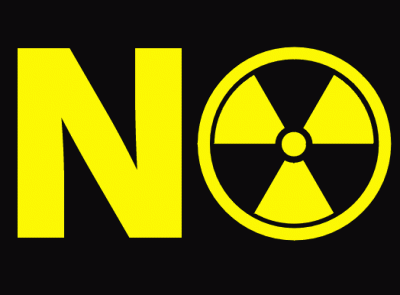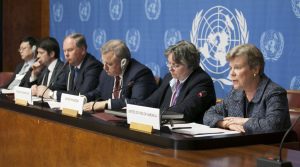A Treaty Banning Nuclear Weapons Is in the Works and What It Could Achieve
UN Press Briefing

At a UN media briefing this week for the United Nations Correspondents Association in New York, nuclear experts and presenters at a UN conference to negotiate a new nuclear ban treaty discussed the current, acute state of nuclear weapons threats, the decline of the post-Cold War nuclear arms regime, and a new initiative led by non-nuclear weapons states to ban nuclear weapons. The briefing was organized by the Nuclear Information and Resource Service and co-sponsored and moderated by Physicians for Social Responsibility.
Unlike existing arms control agreements, the treaty to ban nuclear weapons now under negotiation will be based on humanitarian law, not military law. A draft has been published, and the treaty is likely to be adopted at the current UN conference underway in New York, which ends July 7.
Nuclear weapons states are not participating in the negotiations, but the treaty could still affect them and address growing nuclear threats in important practical ways. Other nuclear treaties were led by nuclear weapons states, which invited non-weapons states to join. For the first time, the ban treaty process reverses that pattern, and presents a new opportunity to change global norms.
That opportunity comes none too soon. From North Korea to Crimea, nuclear tensions and risks are higher now than any time since the height of the Cold War. That contrasts sharply with the expectations of the Nuclear Non-Proliferation Treaty (NPT) regime and other post-Cold War nuclear arms agreements, which call for progressive deep cuts and eventual elimination of nuclear weapons.
“We had huge reductions in nuclear weapons after the Cold War, but now the pace of reduction has slowed, as if we’ve already cleaned out the weapons we wanted to get rid of, and we now estimate our total global inventory of nuclear weapons to be just below 15,000, including many thousands of retired warheads awaiting dismantlement,” said Hans M. Kristensen, Director of the Nuclear Information Project at the Federation of American Scientists and co-author of the World Nuclear Forces overview in the SIPRI Yearbook. “Nuclear weapons in the military arsenals now number about 9500, of which about 1800 are on alert and ready to fly on short notice.”
“All these numbers have declined compared to the Cold War, and the nuclear weapons states emphasize that when they want to show the progress they’re making,” said Kristensen. “Yet nuclear dangers are growing. There’s now a clear trend towards increasing the role of nuclear weapons in limited regional scenarios and improving the effectiveness of nuclear weapons by increasing the accuracy to use lower-yield weapons for targets that used to require higher yield. That tends to make them more credible in the eyes of warfighters and more usable in the eyes of others. We must now change that and reduce nuclear weapons’ role. The ban treaty is an expression of frustration about the lack of progress under the existing treaty regime in doing that.”
“Both US and Russia are modernizing their nuclear arsenals,” said Dr. Matthew McKinzie, Natural Resources Defense Council Senior Scientist and Director of NRDC’s nuclear program.
He and Hans Kristensen are co-authors of a study revealing recent upgrades in targeting capability of US nuclear weapons that have made them significantly more destructive.
“That reveals an expectation that instead of reducing and eliminating nuclear arsenals, we will have these weapons for generations to come. That’s not the future we want.”
“Hans and I count about 1800 nuclear weapons currently on high alert, capable of being launched within ten minutes,” said McKinzie. “Our survival now literally depends on proper day-to-day function of nuclear weapons command and control personnel, computers and systems. What happens if they ever falter? Beyond the power of these weapons, we need to understand the vulnerability they create, including for the states that possess them.”
Dr. Arjun Makhijani, president of the Institute for Energy and Environmental Research, framed the current situation in historical context:
“Briefing President Truman in April 1945, Henry Stimson wrote, ‘if the problem of the proper use of this weapon can be solved, we would have the opportunity to bring the world into a pattern in which the peace of the world and our civilization can be saved.’ This illustrates how nuclear weapons were conceived as weapons of coercion, unilaterally forcing the rest of the world into a ‘pattern.’ The Anti-Ballistic Missile Treaty was an instrument against unilateral, first-strike thinking, but it was renounced by the US in 2002. Much of today’s nuclear tensions originate from that. Today we have a much more complex context than a nuclear monopoly or duopoly.”
“The nuclear ban treaty takes the right view,” said Makhijani. “It is a statement that nuclear weapons are not in not in compliance with humanitarian norms and law; they are out of bounds. Safety cannot be, as Churchill once said of nuclear weapons, ‘the sturdy child of terror’ and survival cannot be ‘the twin brother of annihilation.’”
“The ban treaty is a sturdy seedling of hope, and we must all undertake its care,” said Mary Olson, Southeast Director of the Nuclear Information and Resource Service. “It represents a tectonic shift from military to humanitarian law. The first treaty of this kind, based in humanitarian law, was the landmine ban treaty, which is the most successful treaty in the history of treaties. The land mine ban provides a template, it is in the jurisdiction of Humanitarian Law because of the impacts of land mines on noncombatants, on children and through time. Nuclear weapons also have a disproportionate impact on women, children and on future generations.”
“The second point of the draft nuclear ban treaty preamble refers to disproportionate impacts by gender,” said Olson. “US use of nuclear weapons in Japan left a data set that tells us adult males are ten times more resistant to the health effects of exposure than young females. Those exposed as children had more cancer over their lifetimes. Twice as many girls who were exposed got cancer as boys. In the case of adult exposures, for every two men who died of cancer, three women died. We don’t know why yet, but we know the consequences of exposure are worse than previously thought, and worse than what we’d expect if we only consider adult males.”
“Physicians and scientists have been at the forefront of the nuclear ban treaty negotiations,” noted Jeff Carter, Executive Director of Physicians for Social Responsibility, who moderated the briefing. “The medical community grounds nuclear weapons policy in terms of the empirically known consequences of the use, testing, and development of these weapons on human lives. Informed consent guides the medical community. Patients must understand the consequences of treatment. Similarly, citizens deserve to know the catastrophic harms of nuclear weapons. The nuclear weapons states’ boycott of the ban treaty negotiations illustrates a denial of medical science.”
“All of the evidence points to the consequences of nuclear weapons production, testing and use being worse than we originally thought,” said Dr. Tilman Ruff, MD, Co-President of International Physicians for the Prevention of Nuclear War. “There has been willful denial of the severity, duration and indiscriminate nature of nuclear weapons’ effects. The evidence was often not collected, and where it was collected it was often suppressed and ignored. But there is groundbreaking scientific analysis showing that using less than half a percent of today’s nuclear arsenals (less than a tenth of a percent of their total yield) on cities would cool, darken and dry the surface of the whole planet, decimating agriculture and putting billions in jeopardy from starvation. Britain, France, China, Israel, India and Pakistan have smaller arsenals, but even these pose a global threat.”
“It’s not enough to present this evidence. We have a responsibility to make sure the evidence is understood, its implications seen and acted upon. The ban treaty does this. Food security, health impacts, disproportionate impacts on women and girls are all included. It brings the interests of global humanity and democracy towards eliminating nuclear weapons. I have no doubt it will have a substantial impact, including on the nuclear weapons states, despite the fact they are not here negotiating it. In the General Assembly, the United States wrote to its allies warning them that if the ban treaty negotiations proceed, not to join them. They argued the ban treaty would delegitimize nuclear weapons and planning. That means the US recognizes that the treaty will work as intended.”
Featured image: In My Short Sleeve


